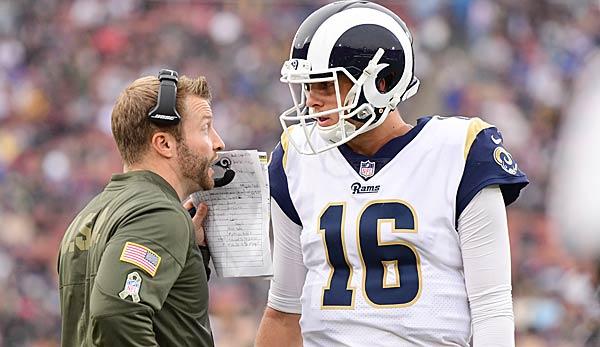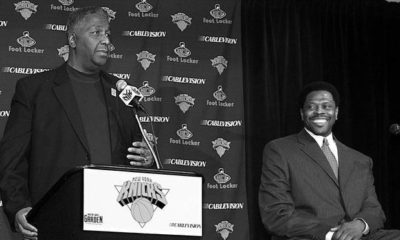US-Sport
NFL: Play-Calling explained: Everything can change in 40 seconds
What a difference a year can make! The Los Angeles Rams are the best example of this: After having an incredibly uncreative and harmless offense under Head Coach Jeff Fisher, Sean McVay’s successor, Sean McVay, has torn the rudder schematically around. Last season Kyle Shanahan was the yardstick for play calling, and in 2015 the league raved about Bruce Arians’ downfield concepts. But what is it all about? What is important when coaches decide on moves during a match? SPOX plunges into the history and art of offensive play-calling.
Football is a complex sport. The deeper you go, the more you discover – and the questions about strategy and tactics are not always easy to answer. A crucial aspect of this is the playbook, just like the play-calling, i. e. the announcement of the moves, and the game planning, i. e. the preparation for a certain opponent. In a two-part mini-series, SPOX looks at precisely these central aspects. After the big interview in part 1, part 2 focuses on offensive play calling.
When fans discover football for themselves, their approach is often quite similar. At first glance, the physics, athletics and show are impressive. At second, third and fourth glance, however, the tactical element is added. This actually starts with the creation of a playbook, but what fans can see and follow every week is the play-calling.
The coaches have 40 seconds between two plays to announce the next move. The task is to process an enormous variety of information: What tendencies does the opponent reveal? Is there a danger of developing trends yourself? Where in the field are you, which strengths and weaknesses have to be considered on both sides of the ball?
Or to put it another way: In the ultra-athletic chaos on the football field, which is boiling with emotions and is dominated by the volume of the fans, play calling is an art that gives football its great tactical component and makes it the ultimate lawn chess.
To shed light on these, SPOX has spoken to two coaches and also explains the approaches of the game’s great minds that have revolutionized play-calling. Because every week counts anew: everything can change in 40 seconds.
In the 1950s, the football landscape was a completely different one. The NFL and the AFL were still more than ten years away from their union, the college version was clearly superior to professional football in public standing, before “The Greatest Game Ever Played” finally marked a turning point in 1958. And the Cleveland Browns were an annual title contender.
Yeah, those Cleveland Browns. They were a powerhouse not only with the legendary Jim Brown, but also with Cleveland’s legendary couch Paul Brown before the spectacular halfback.
In addition to various other innovations that still characterize the game today, it is his fault that quarterbacks are no longer responsible for playing the game. This was still standard at the beginning of the 1950s, so the coaches’ influence during a match was much lower.
Brown changed that. He wanted more control, he wanted to announce the moves – and started using a player as a kind of message relay. So the player came to the sidelines, got the play call from Brown and then passed it on to the other players in the Huddle. It didn’t take long before Brown used radio technology to send the moves directly into the helmet for the quarterback. Incidentally, radio technologies that were still in their infancy for a while: When games were played in New York, for example, it happened so many times that the quarterback suddenly had other radio waves – such as the police radio – in his ears.
Nevertheless, progress was unstoppable and more and more coaches took over the play calling responsibility. Currently, the NFL’s 18 head coaches with their offensive style are currently 13, who announce the offense plays in the game: Ben McAdoo (Giants), Sean Payton (Saints), Mike McCarthy (Packers), Andy Reid (Chiefs), Jay Gruden (Redskins), Bruce Arians (Cardinals), Doug Pederson (Eagles), Kyle Shanahan (49ers
“The coach announcing the plays must have full control over all moves,”said legendary Niners coach Bill Walsh, who learned from Brown himself, in a conversation with the New York Times in 1996. And he always needs to keep a cool head:”When I was still responsible for play calling in Cincinnati early in my career, I was always arguing on the sidelines with running-back coach Bill Johnson. He just wanted to announce runs, if it had gone after me, we would have just thrown the whole time. This has taught me that if you want to enforce your philosophy as a coach, you’ll quickly get into trouble.”
At the same time, Walsh spoke of an increasingly “sophisticated” method of dealing with the sport, which had been introduced thanks to Brown. McVay, under whom Jared Goff and the Rams-Offense are unrecognizable, recently summed it up in The Ringer:”There’s nothing better than to announce a play that gives you the kind of formation you want and puts your players in a position from which they can succeed”.
A process of simplification has been introduced here – at least in part. The announcement of the placements became more efficient and shorter, but also more differentiated. Mario Campos Neves looks back on a long track record as Head Coach and Offensive Coordinator in the GFL and has been trained by Nick Saban’s coaching staff in Alabama,”My general approach is to keep things as simple as possible,” he said in a conversation with SPOX. I’m not a fan of using long play calls.”
In the beginning, this was exactly what happened under Brown: In the first steps, the wording of a move consisted of the complete single parts of the respective move – i. e. every route, every concept within the layout was announced individually. Play calls are no longer that specific, but there is no single standard system. Rather, the picture is determined by three comprehensive schools.
Brown Left 22 Texas “can contain the formation (” Brown Left “), most of the routes (the first” 2 “), the blocking scheme (the second” 2) and a specific route within the plot (“Texas”). In the Coryell Offense, each route has a number assigned to it, which is then extended in the play call by the route of the running back.”847 H-Shallow” would be a typical play call for it. Each receiver on the course knows whether it is the first (in the case of “8”-route), second (“4”) or third (“7”) receiver and must therefore only pay attention to its number.
It becomes more difficult in the Erhardt-Perkins Offense, which is extremely flexible and is best known from the New England Patriots. On the one hand, because the receivers have different built-in options within a plot. As a reaction to the Defense, they can change and adjust their process route, which is called “Option Routes”.
On the other hand, however, the complexity can also be found in play calling itself: Route combinations are given fixed names and so the placements are extremely interchangeable and flexible, but require a great deal of learning work from the receivers and quarterback. A play could be called “G Brown RT 80 Hot Delay Utah”. the bracelet with Tom Brady’s plays in the Patriots Museum offers a little taste.
Ultimately, play calling and the design of the offense is also about not being stubbornly stuck in one track. The language of the playbook – the name of the plays – is one aspect. The implementation and adaptation of the layouts to your own team is a completely different matter.
Jeff Reinebold, who has been a college and CFL coach for many years, put it this way:”You have to understand who your own players are and what they are good at in order to put them in a position where they can use their strengths. If your running back likes to run well outwards because it has the necessary explosiveness, then don’t let it run constantly inwards between the tackles! The same goes the other way around if you have a power back.”
Mario Campos Neves continued:”I am basically of the opinion: Players over Scheme. So if my players don’t like certain things, it doesn’t make sense if I want to push them through. Of course, you shouldn’t give up things just because they didn’t work out for once. But the general involvement of the players and offensively especially the quarterback is extremely important. Whoever is aggressively responsible for the play calling has to be on the same wavelength with the quarterback. The players also need to understand what you want from them and develop a situational understanding.”
Play calling is about a few central elements: it’s about putting your own players in the best possible position. That is, to prepare certain layouts over the course of a game, for example by running a play from the same formation over and over again – and suddenly announcing something completely different. It is also about exploiting opposing tendencies and hiding your own tendencies.
And the ultimate goal is to triumph over the opponent in a lawn-chess duel, not only in the single move, but also with a view to the big picture. This also includes the detection of good matchups. Kyle Shanahan is worth mentioning again, as the Falcons dominated this discipline last season better than any other team. The two successive away games in Denver and Seattle against two of the best defenses in the league were a prime example: against the Broncos, Shanahan repeatedly attacked the linebacker with his running backs, who was vulnerable to coverage, and against the Seahawks, he deliberately attacked the Seahawks with his tight ends – a tactic that the Falcons still use today.
Page 1: Paul Brown and Bill Walsh as pioneers and the three major offensive systems
Page 2: Play-scripting, the feeling for game flow and the art of foresight


















You must be logged in to post a comment Login